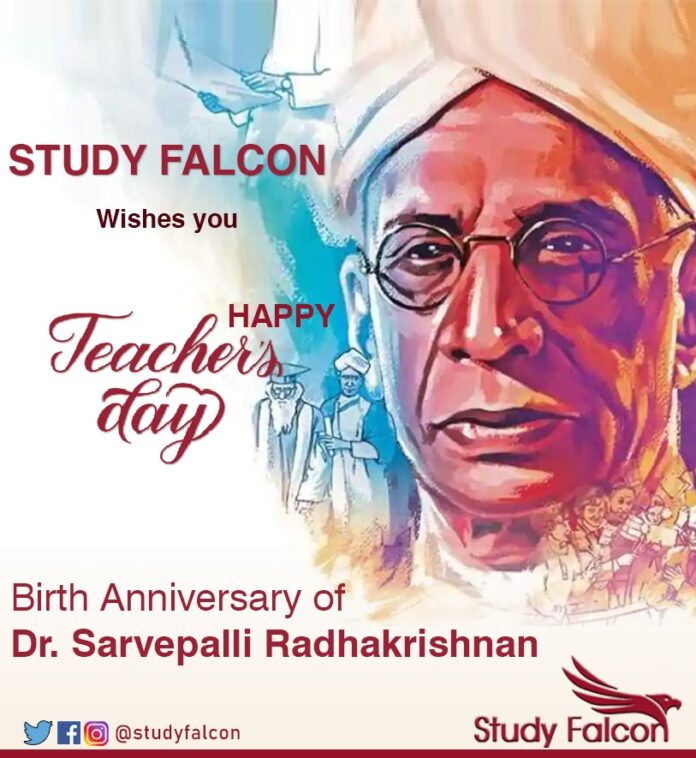Teacher’s Day commemorate the birth anniversary of Dr. Sarvepalli Radhakrishnan who was a scholar, recipient of Bharat Ratna, first Vice President and second President of independent India. He was born on 5 September, 1888. He was a grand advocate of edification, and was the distinguished envoy, academician, and India’s President, above all a great Teacher. He was a great scholar, philosopher and Bharat Ratna recipient.
It was in 1962 when Dr Radhakrishnan became the President of India that his birthday came to be observed as Teachers’ Day. It is said that Dr Radhakrishnan’s students were keen to celebrate his birthday. However, he suggested instead of celebrating his birthday, it would be his “proud privilege” if the day was observed as Teachers’ Day instead. The appeal showed Dr. S. Radhakrishnan’s affection and dedication for the teaching career. From that point of time, India celebrates Teacher’s Day on 5th September.
Sarvepalli Radhakrishnan was born in a Telugu-speaking Niyogi Brahmin Hindu family, in Tiruttani in the erstwhile Madras Presidency. In 1904, Radhakrishnan entered Madras Christian College. At this time Radhakrishnan’s academic sensibilities lay with the physical sciences, and before beginning his MA degree in 1906 his interest appears to have been law. He graduated from there in 1906 with a Voorha master’s degree in Philosophy, being one of its most distinguished alumni.

Upon the completion of his MA degree in 1908, Radhakrishnan found himself at both a financial and professional crossroads. His obligations to his family precluded him from applying for a scholarship to study in Britain and he struggled without success to find work in Madras. The following year, with the assistance of William Skinner at Madras Christian College, Radhakrishnan was able to secure what was intended to be a temporary teaching position at Presidency College in Madras.
At Presidency College, Radhakrishnan lectured on a variety of topics in psychology as well as in European philosophy. As a junior Assistant Professor, logic, epistemology and ethical theory were his stock areas of instruction. At the College, Radhakrishnan also learned Sanskrit.
During these years, Radhakrishnan was anxious to have his work published, not only by Indian presses but also in European journals. The Guardian Press in Madras published his MA thesis, and scarcely revised portions of this work appeared in Modern Review andThe Madras Christian College Magazine. While Radhakrishnan’s efforts met with success in other Indian journals, it was not until his article “The Ethics of the Bhagavadgita and Kant” appeared in The International Journal of Ethics in 1911 that Radhakrishnan broke through to a substantial Western audience. As well, his edited lecture notes on psychology were published under the title Essentials of Psychology.
Between 1914 and 1920, Radhakrishnan continued to publish. He authored eighteen articles, ten of which were published in prominent Western journals such as The International Journal of Ethics, The Monist, and Mind. Throughout these articles, Radhakrishnan took it upon himself to refine and expand upon his interpretation of Hinduism. Radhakrishnan’s articles and books during this period reflect his desire to offer a sustainable philosophical response to the unfolding discontent he encountered. World War One and its aftermath, and in particular the events in Amritsar in the spring of 1919, further exacerbated Radhakrishnan’s patience with what he saw as an irrational, dogmatic, and despotic West. Radhakrishnan’s 1920 The Reign of Religion in Contemporary Philosophy is indicative of his heightened polemical sensibilities during this period.

the isolation Radhakrishnan experienced during his early years in Calcutta allowed him to work on his two volume Indian Philosophy, the first of which he began while in Mysore and published in 1923 and the second followed four years later. Throughout the 1920s, Radhakrishnan’s reputation as a scholar continued to grow both in India and abroad. He was invited to Oxford to give the 1926 Upton Lectures, published in 1927 as The Hindu View of Life, and in 1929 Radhakrishnan delivered theHibbert Lectures, later published under the title An Idealist View of Life. The later of these two Views is Radhakrishnan’s most sustained, non-commentarial work. An Idealist View of Life is frequently seen as Radhakrishnan’s mature work and has undoubtedly received the bulk of scholarly attention on Radhakrishnan.
Dr Radhakrishnan was a celebrated academic. He taught at Chennai’s Presidency College and Calcutta University. He served as Vice-Chancellor of Andhra University from 1931 to 1936. In 1936, Dr Radhakrishnan was invited to fill the Chair of Spalding Professor of Eastern Religions and Ethics at Oxford which he retained for 16 years.
Radhakrishnan was knighted in 1931, the same year he took up his administrative post as Vice Chancellor at the newly founded, though scarcely constructed, Andhra University at Waltair. Sir Radhakrishnan served there for five years as Vice Chancellor, when, in 1936, not only did the university in Calcutta affirm his position in perpetuity but Oxford University appointed him to the H.N. Spalding Chair of Eastern Religions and Ethics. In late 1939, Radhakrishnan took up his second Vice Chancellorship at Benares Hindu University (BHU), and served there during the course of the second world war until mid-January 1948, two weeks before Gandhi’s assassination in New Delhi.

Shortly after his resignation from BHU, Radhakrishnan was named chairman of the University Education Commission. The Commission’s 1949 Report assessed the state of university education and made recommendations for its improvement in the newly independent India. Though co-authored by others, Radhakrishnan’s hand is felt especially in the chapters on The Aims of University Education and Religious Education.
Radhakrishnan represented India at UNESCO (1946–52) and was later Ambassador of India to the Soviet Union, from 1949 to 1952. He was also elected to the Constituent Assembly of India. Radhakrishnan was elected as the first Vice-President of India in 1952, and elected as the second President of India.











